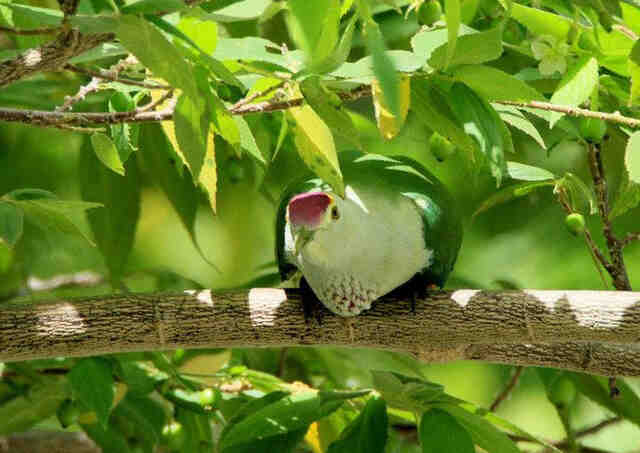Treron formosae
IUCN
LCBasic Information
Scientific classification
- name:Treron formosae
- Scientific Name:Taiwan Green Pigeon,Treron formosae,Whistling Green Pigeon
- Outline:Landfowl
- Family:Columbiformes Columbidae G.Pigeon
Vital signs
- length:32-33cm
- Weight:200-340g
- lifetime:10-16years
Feature
The forehead, top of the head and nape of the male bird are orange-red.
Distribution and Habitat
The Red-crowned Green Pigeon is distributed in the Ryukyu Islands, Okinawa, Japan to the Philippine Islands, and in Hualien, Tainan, Kaohsiung, Pingtung, Taitung, Green Island and Lanyu in Taiwan.
The Red-crowned Green Pigeon is a resident bird that inhabits dense evergreen broad-leaved forests, mixed forests, tropical and subtropical forests, farmlands in plains and hilly areas below 2,000 meters above sea level. In Taiwan, it is mainly found in mountainous areas, and in the Ryukyu Islands, it is found in wooded areas consisting of permanent broad-leaved forests and even inland or urban peri-urban gardens.
Appearance
The forehead, head and pillow of the male red-capped green dove are orange-red, which is one of the main features that distinguishes it from other green doves. The feathers on the nape, back, and up to the upper tail are olive green, with a slight hint of grape red on the back. The tail feathers are dark green or yellow-green, in an inconspicuous wedge shape, and there is no black on both sides. The flight feathers are dark brown, the middle coverts and minor coverts are brown-purple maroon, forming significant brown-purple maroon patches on the wings. The lower body is yellow-green, the chest and abdomen are darker green, and the center of the abdomen is yellow-white.
The coverts on the female's head, neck, back and wings are all olive green. The middle coverts and minor coverts are olive green, not brownish-purple. The underparts are dark green. The head, front neck and chest should be free of orange stains.
The outer ring of the iris is blood red and the inner ring is pur
Details
The Whistling Green Pigeon has four subspecies.

The Whistling Green Pigeon often moves alone, in pairs or in small groups, especially in the morning and evening. It mainly moves and forages in the tree canopy. It is a frugivorous bird: it mainly consumes a variety of fruits, seeds and berries, however, it clearly prefers and tends to eat figs.
The breeding season of the Red-crowned Green Pigeon is from February to May. It nests in tall trees in the forest. The nest is usually placed in a tree of the genus Casuarina, only 3 meters above the ground, and is built on the branches. It is flat and very simple, mainly made of dead branches. Each nest lays 2 oval eggs. The color of the eggs is white, smooth and without spots. The incubation period and the feeding method of the parents are unknown.
During the brooding period of pigeons, pigeon milk is secreted under the action of prolactin (also known as prolactin) secreted by the posterior lobe of the pituitary gland. Pigeon milk is composed of fat particles, emulsified fat chyle and lymph fluid secreted by the proliferating flat epithelium of the bilateral lateral sac lymphatic area of female and male pigeons, that is, the lymphatic area of the crop bed. After the colostrum period, chyle fluid rich in emulsified fat particles is gradually added. The lymph papilla of the epithelial lymphatic papilla on the crop bed generally begins to sprout on the 4th to 5th day of the incubation state. The crop bed of male and female pigeons begins to move, the blood vessels of the crop bed are congested and thickened, and the lymphatic vessels proliferate. On the 8th to 9th day, the crop epithelium thickens and enters the pre-brooding state. On the 13th day, its thickness and width have increased by 1 times. On the 14th to 16th day, it can secrete transparent slightly yellow pigeon milk. On the 18th day, the crop can secrete crop milk. However, on the 7th day after the squab hatches, the amount of crop milk secretion begins to decrease, and the secretion stops on the 10th day. It continues to vomit until the chicks are about 2 weeks old, the crop bed begins to shrink, and the secretion of pigeon milk gradually stops. The chyme is gradually mixed with semi-finished chyme ground by the gizzard from the glandular stomach, and then turned into pelleted feed mixed with water for direct feeding. If the incubated eggs fail to hatch on time, the incubation of pigeons with good incubation can be delayed to the 22nd-24th day at most (these are all related to the incubation of pigeons, incubation season and embryonic development information feedback, the frequency of hatching of fetuses, etc., such as cold winter and spring and brooding period, the incubation period will often be automatically extended, and it is often difficult to persist in the hot and humid summer days), at this time, the brooding pigeons will automatically stop incubating with the shrinkage of the crop bed.
Rare in Taiwan Island, China and the Philippines. Common in the Ryukyu Islands. Given its highly fragmented island habitat, it is considered near threatened.
Listed in the 2012 Red List of Endangered Species of the World Conservation Union (IUCN) ver3.1 - Near Threatened (NT).
Listed in the second level of the "List of National Key Protected Wildlife in China".
Protect wildlife and eliminate game.
Maintaining ecological balance is everyone's responsibility!








